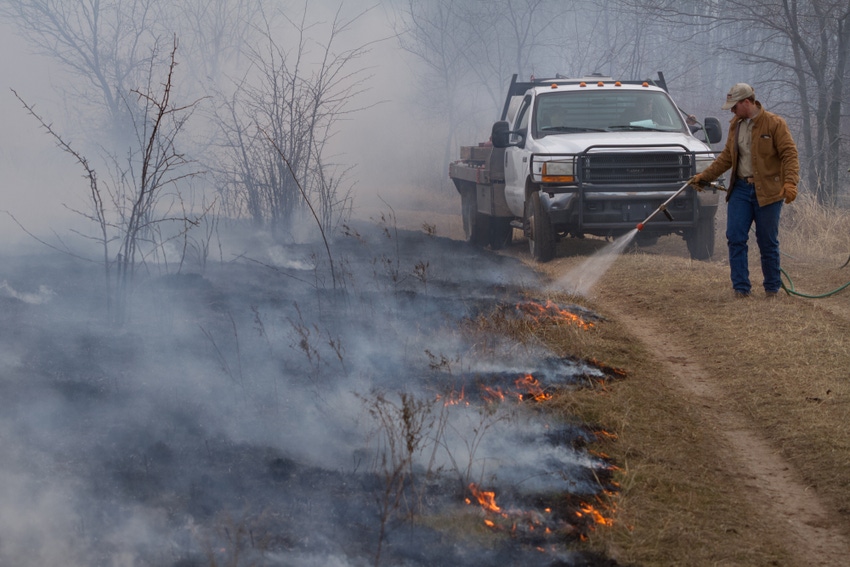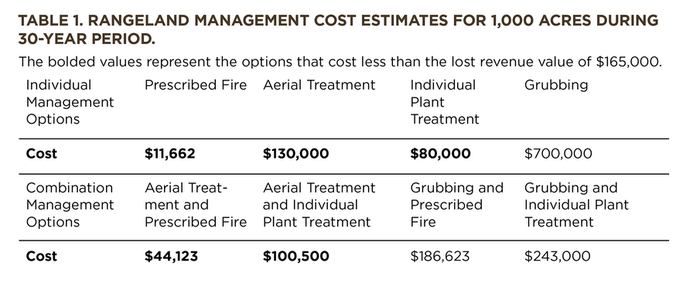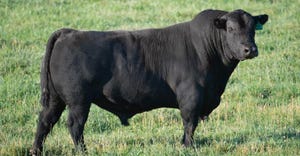What’s the most economical way to defeat brush and improve range?
The most economic kind of brush control may not necessarily be the best for you. Here’s a look at the numbers.
July 26, 2018

By Myriah Johnson
Every rancher has some sort of a to-do list. It may be highly prioritized or it may be a long list of all the things that need to be done, in no particular order.
Regardless of what your list looks like, there are tasks that need to be done right away and tasks that still need to be done, but in the future, like brush control and pasture improvement.
Often, range management or improvement projects fall in the nonessential category until they reach a critical point. Along the way, these projects may be continually pushed to the back burner for many reasons, such as shortages in time, labor or capital. However, it is best to consider whether there is a financial incentive (or penalty) for waiting until there is a critical mass to address this type of project.
Increased brush reduces revenue
For this article, we will focus on what would happen to a range pasture if mesquite was not managed over a 30-year time period.
The article "Economics of Managing Mesquite in North Texas: A Sensitivity Analysis", written by W.R. Teague, R.J. Ansley, U.P. Kreuter, W.E. Pinchak and J.M. McGrann and published by the Journal of Range Management in 2001, lends itself to this idea. An area completely clear of mesquite is assumed to start with. This clear land will support slightly less than 0.12 animal unit years (AUYs) per hectare (or slightly more than 21 acres per AUY).
For the first 15 years or so, mesquite coverage slowly increases to about 15% and only a minimal decrease in AUYs per hectare occurs (or a minimal increase in the number of acres per AUY). However, in years 15 to 30, as mesquite coverage increases from approximately 15% to 30%, we observe a steady decline in carrying capacity to less than 0.04 AUYs per hectare (or more than 62 acres per AUY). During these 30 years, there is a reduction in grazeable acres and carrying capacity.
Because fewer head of livestock can be supported, fewer pounds of livestock production per acre are sold. In addition, this creates a loss in revenue, leaving a producer with fewer dollars to pay for this type of range management. Further, there is an increase in the production cost per unit of livestock.
Consider loss of revenue when evaluating practices
None of the aforementioned consequences are desired, but how does one justify implementing the management practices needed to avoid this situation? One way to look at this is to think of the potential lost revenue from not managing the rangeland.
We will assume there are 1,000 acres in the operation and that 500-pound calves are weaned and sold each October. If the cows weigh 1,100 pounds, on average the 1,000 acres will support 41 cows total (24 acres per cow). With an 85% weaning rate, there would be 35 calves to market each fall.
As discussed previously, this herd size could be supported for the first 15 years or so. At year 18, we assume the operation can support 33 cows with 28 calves to market; at year 23, 22 cows and 18 calves; at year 28, 16 cows and 13 calves; and finally, at year 30, 14 cows and 11 calves.
To calculate the loss in revenue, we compare the pounds that would have been marketed if the land was clear to the pounds marketed when the carrying capacity is decreased. For example, take the 18 calves, instead of 35, marketed at year 23. Assume a calf crop of 50% steers and 50% heifers. Using Oklahoma City market prices from 2000 to 2017 for 500- to 600-pound steers and heifers, it is estimated that approximately $165,000 in revenue would be lost.
Calculate costs for management options
So, what options are available for mesquite control that would be less costly than losing out on $165,000 in revenue?
We estimated the costs of several management methods to answer this question. The methods included prescribed fire, aerial treatment, individual plant treatment (IPT) andgrubbing as well as the combination of aerial treatment and prescribed fire or IPT and the combination of grubbing and prescribed fire or IPT. We assumed these management practices were started in year 13, just before destocking would begin.
By implementing these practices, destocking would not be needed. The following calculations are rough estimates based on the Noble agricultural consultants' knowledge.
Prescribed fire
Initial startup cost of $10,960 for a sprayer, fire guards and other supplies.
We assumed 200 acres would be burned each year with an annual cost of $39.
Total cost over 30-year period: $10,960 + ($39 x 18 years) = $11,662
One consideration for prescribed fire is that mature trees at high densities could lead to less-than-desirable suppression levels and not result in an increase in carrying capacity.
Individual plant treatment (IPT)
$20,000 every five years, four treatments in 18-year time frame.
Total cost over 30 years: $20,000 x 4 = $80,000
IPT can be cheaper at lower canopy and density levels but may be less feasible at higher density levels and with more mature trees. Also, cut and spray may be the only IPT option when trees are larger.
Aerial treatment
$32,500 every five years with four treatments in an 18-year time frame.
Total cost over 30 years: $32,500 x 4 = $130,000
Aerial treatment followed by prescribed fire each year
Add one-time cost for aerial treatment ($32,500), plus prescribed fire startup cost ($10,960) and annual burn cost ($39) for 200 acres.
Total cost over 30 years: $32,500 + $10,960 + ($39 x 17 years) = $44,123
Aerial treatment followed by IPT each year
IPT annual cost: $20 per acre x 200 acres per year = $4,000
Total cost over 30 years: $32,500 + ($4,000 x 17 years) = $100,500
Grubbing
$175,000 every five years, four treatments in an 18-year time frame.
Total cost over 30 years: $175,000 x 4 = $700,000
Grubbing followed by prescribed fire each year
Add one-time grubbing cost ($175,000), plus prescribed fire startup cost ($10,960) and annual burn cost ($39) for 200 acres.
Total cost over 30 years: $175,000 + $10.960 + ($39 x 17 years) = $186,623
Grubbing followed by IPT each year
Add one-time grubbing cost ($175,000), plus IPT annual cost ($4,000) for 200 acres.
Total cost over 30 years: $175, 000 + ($4,000 x 17 years) = $243,000
In total, there are eight different management options ranging in cost from about $11,662 to $700,000. In Table 1, the bolded values represent the options that cost less than the lost revenue value of $165,000. Five options meet the threshold. Prescribed fire is the cheapest at $11,662. It is followed by the combination of aerial treatment and prescribed fire, then IPT, then aerial treatment and IPT, and finally aerial treatment, with an approximate cost of $130,000.

Some producers have suggested the prescribed fire cost is double what is assumed here. Even at double the cost, prescribed fire remains the most economical option.
Four economic considerations
You must have the cash on hand to implement the management practices discussed in this article. Just because you stand to lose revenue does not necessarily mean you have the cash on hand to implement the practices. So, you should consider setting cash aside for range management practices.
Consider the fact that the costs to implement any of these practices may increase with deferment. As always, the pencil and paper must come together to determine the implementation costs for any of these practices on your operation.
Check with your local Natural Resources Conservation Service office to determine whether any funding assistance is available.
Consider whether you can afford to defer implementing management practices or suffer the loss in your future income stream.
Johnson is economics program lead and agricultural economics consultant at the Noble Research Institute. Rob Cook, pasture and range consultant; Will Moseley, wildlife and fisheries consultant; Steven Smith, wildlife and fisheries consultant; and Brian Hays contributed information to this article.
You May Also Like


.png?width=300&auto=webp&quality=80&disable=upscale)
